I enjoyed reading two excellent articles in a dialogue about design with intent—the practice of strategically designing to influencing user behavior—and how user centered design process fits or is at oods with the designer's desire to influence. The first is Robert Fabricant's article on "Design with Intent: how designers can influence behavior", and the follow up is Dan Lockton's "frog design on Design with Intent".
User centered design focuses primarily on user needs and research and decision making must support these needs. Because of this, the argument being made by Frog Design's Robert Fabricant is that UCD puts designers a step removed from playing an active role in influencing behavior in ways reflective of their own values and judgement, and the desire to engage more directly has led designers to push outside of the boundaries of the purist's definition of UCD practice.
In a typical UCD designed product, the designer tends to disappear and the user's engagement with the designed product or experience is judged by the essence of understanding and predictability of need intrinsic in the product design—to me the essence is the ability to allow frictionless or enjoyable use, made possible by the design and designer. Fabricant wrote that designers want to have more of an active and immediate role in behavior change through social engagement, and are doing so in more apparent ways. This is taking shape through direct engagement with users through practices intended to influence their behavior positively. The three mentioned themes in play are Persuasion Design, Catalyst Design, and Performance Design. Catalyst and Performance Design are new terms to me, but the concepts and some of the examples of participatory design, more direct involvement with users, or providing open architectures for user involvement with design on web products are familiar.
Dan Lockton, author of the Design With Intent site, writes that the notion of "direct behavior design" is something often perceived along the lines of architectural determinism or behaviorism, and warns that awareness that someone is trying to determine and influence your behavior often leads to an emotional reactance—the very idea that one's freedom is being restricted or one's behavior being persuasively pushed in some direction causes irritation. He also says that while Fabricant believes design with intent may be opposed to the principles of the user centered design philosophy, it needn't be viewed this way. To quote:
I would argue that in cases where design with intent, or design for behaviour change, is aligned with what the user wants to achieve, it’s very much still user-centred design, whether enabling, motivating or constraining. It’s the best form of user-centred design, supporting a user’s goals while transforming his or her behaviour. Some of the most insightful current work on influencing user behaviour ... starts with achieving a deeper understanding of user behaviour with existing products and systems, to identify better how to improve the design.
I think the argument could be made that somewhere in the process of injecting the designer into the users' experience, especially in the more apparent and active examples of Catalyst Design and Performance Design, that the approach to engaging with users is entirely more active and immersed in users' awareness than what I've ever understood User Centered Design to encompass. It doesn't really matter to me in the end, whether this expanding role of the designer from designing for use, to influencing behavior is contrary to any given process. What matters to me is where you see the lines of responsibility, and how easily you can cross them for the users' benefit while doing no harm. A more engaged designer needn't be on the "genius designer" end of the spectrum to have to believe that they might provide a needed role by influencing new or different behavior that helps achieve user goals, for instance, rather than perpetuating existing models.
http://designmind.frogdesign.com/articles/power/design-with-intent.html
